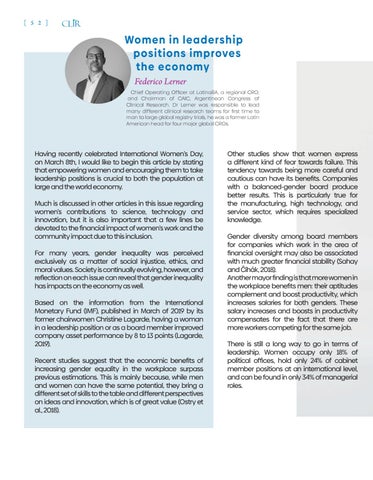[ 5 2 ]
Women in leadership positions improves the economy Federico Lerner Chief Operating Officer at LatinaBA, a regional CRO; and Chairman of CAIC, Argentinean Congress of Clinical Research. Dr Lerner was responsible to lead many different clinical research teams for first time to man to large global registry trials, he was a former Latin American head for four major global CROs.
Having recently celebrated International Women’s Day, on March 8th, I would like to begin this article by stating that empowering women and encouraging them to take leadership positions is crucial to both the population at large and the world economy. Much is discussed in other articles in this issue regarding women’s contributions to science, technology and innovation, but it is also important that a few lines be devoted to the financial impact of women’s work and the community impact due to this inclusion. For many years, gender inequality was perceived exclusively as a matter of social injustice, ethics, and moral values. Society is continually evolving, however, and reflection on each issue can reveal that gender inequality has impacts on the economy as well. Based on the information from the International Monetary Fund (IMF), published in March of 2019 by its former chairwomen Christine Lagarde, having a woman in a leadership position or as a board member improved company asset performance by 8 to 13 points (Lagarde, 2019). Recent studies suggest that the economic benefits of increasing gender equality in the workplace surpass previous estimations. This is mainly because, while men and women can have the same potential, they bring a different set of skills to the table and different perspectives on ideas and innovation, which is of great value (Ostry et al., 2018).
Other studies show that women express a different kind of fear towards failure. This tendency towards being more careful and cautious can have its benefits. Companies with a balanced-gender board produce better results. This is particularly true for the manufacturing, high technology, and service sector, which requires specialized knowledge. Gender diversity among board members for companies which work in the area of financial oversight may also be associated with much greater financial stability (Sahay and Čihák, 2018). Another mayor finding is that more women in the workplace benefits men: their aptitudes complement and boost productivity, which increases salaries for both genders. These salary increases and boosts in productivity compensates for the fact that there are more workers competing for the same job. There is still a long way to go in terms of leadership. Women occupy only 18% of political offices, hold only 24% of cabinet member positions at an international level, and can be found in only 34% of managerial roles.




















